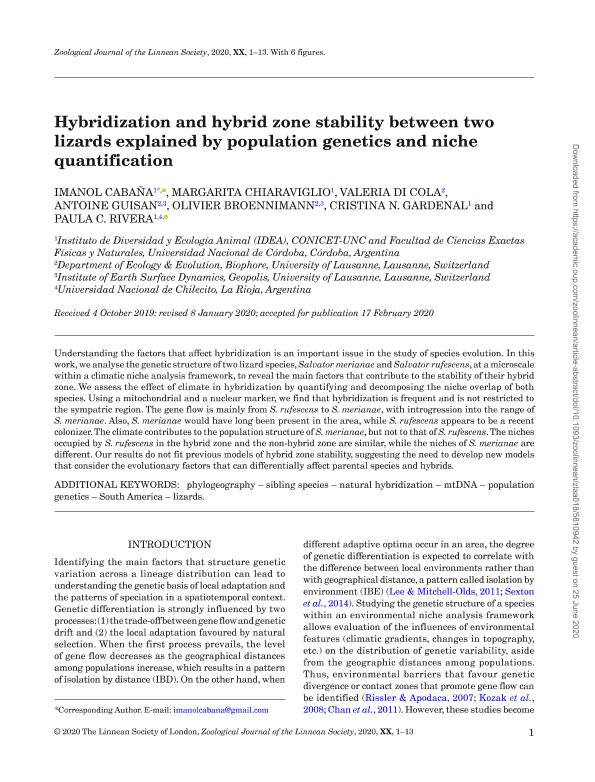Mostrar el registro sencillo del ítem
dc.contributor.author
Cabaña, Juan Imanol

dc.contributor.author
Chiaraviglio, Margarita

dc.contributor.author
Di Cola Bucciarelli, Valeria

dc.contributor.author
Guisan, Antoine

dc.contributor.author
Broennimann, Olivier
dc.contributor.author
Gardenal, Cristina Noemi

dc.contributor.author
Rivera, Paula Cecilia

dc.date.available
2021-09-27T17:46:16Z
dc.date.issued
2020-10-21
dc.identifier.citation
Cabaña, Juan Imanol; Chiaraviglio, Margarita; Di Cola Bucciarelli, Valeria; Guisan, Antoine; Broennimann, Olivier; et al.; Hybridization and hybrid zone stability between two lizards explained by population genetics and niche quantification; Wiley Blackwell Publishing, Inc; Zoological Journal of the Linnean Society; 190; 2; 21-10-2020; 757-769
dc.identifier.issn
0024-4082
dc.identifier.uri
http://hdl.handle.net/11336/141610
dc.description.abstract
Understanding the factors that affect hybridization is an important issue in the study of species evolution. In this work, we analyse the genetic structure of two lizard species, Salvator merianae and Salvator rufescens, at a microscale within a climatic niche analysis framework, to reveal the main factors that contribute to the stability of their hybrid zone. We assess the effect of climate in hybridization by quantifying and decomposing the niche overlap of both species. Using a mitochondrial and a nuclear marker, we find that hybridization is frequent and is not restricted to the sympatric region. The gene flow is mainly from S. rufescens to S. merianae, with introgression into the range of S. merianae. Also, S. merianae would have long been present in the area, while S. rufescens appears to be a recent colonizer. The climate contributes to the population structure of S. merianae, but not to that of S. rufescens. The niches occupied by S. rufescens in the hybrid zone and the non-hybrid zone are similar, while the niches of S. merianae are different. Our results do not fit previous models of hybrid zone stability, suggesting the need to develop new models that consider the evolutionary factors that can differentially affect parental species and hybrids.
dc.format
application/pdf
dc.language.iso
eng
dc.publisher
Wiley Blackwell Publishing, Inc

dc.rights
info:eu-repo/semantics/openAccess
dc.rights.uri
https://creativecommons.org/licenses/by-nc-sa/2.5/ar/
dc.subject
LIZARDS
dc.subject
MTDNA
dc.subject
NATURAL HYBRIDIZATION
dc.subject
PHYLOGEOGRAPHY
dc.subject
POPULATION GENETICS
dc.subject
SIBLING SPECIES
dc.subject
SOUTH AMERICA
dc.subject.classification
Biología

dc.subject.classification
Ciencias Biológicas

dc.subject.classification
CIENCIAS NATURALES Y EXACTAS

dc.title
Hybridization and hybrid zone stability between two lizards explained by population genetics and niche quantification
dc.type
info:eu-repo/semantics/article
dc.type
info:ar-repo/semantics/artículo
dc.type
info:eu-repo/semantics/publishedVersion
dc.date.updated
2021-09-06T15:38:44Z
dc.identifier.eissn
1096-3642
dc.journal.volume
190
dc.journal.number
2
dc.journal.pagination
757-769
dc.journal.pais
Reino Unido

dc.journal.ciudad
Londres
dc.description.fil
Fil: Cabaña, Juan Imanol. Consejo Nacional de Investigaciones Científicas y Técnicas. Centro Científico Tecnológico Conicet - Córdoba. Instituto de Diversidad y Ecología Animal. Universidad Nacional de Córdoba. Facultad de Ciencias Exactas Físicas y Naturales. Instituto de Diversidad y Ecología Animal; Argentina
dc.description.fil
Fil: Chiaraviglio, Margarita. Consejo Nacional de Investigaciones Científicas y Técnicas. Centro Científico Tecnológico Conicet - Córdoba. Instituto de Diversidad y Ecología Animal. Universidad Nacional de Córdoba. Facultad de Ciencias Exactas Físicas y Naturales. Instituto de Diversidad y Ecología Animal; Argentina
dc.description.fil
Fil: Di Cola Bucciarelli, Valeria. Universite de Lausanne; Suiza. Universidad Nacional de Córdoba. Facultad de Cs.exactas Físicas y Naturales. Departamento de Diversidad Biológica y Ecológica. Cátedra de Biología del Comportam. y Div. Animal Ii; Argentina. Consejo Nacional de Investigaciones Científicas y Técnicas; Argentina
dc.description.fil
Fil: Guisan, Antoine. Universite de Lausanne; Suiza
dc.description.fil
Fil: Broennimann, Olivier. Universite de Lausanne; Suiza
dc.description.fil
Fil: Gardenal, Cristina Noemi. Consejo Nacional de Investigaciones Científicas y Técnicas. Centro Científico Tecnológico Conicet - Córdoba. Instituto de Diversidad y Ecología Animal. Universidad Nacional de Córdoba. Facultad de Ciencias Exactas Físicas y Naturales. Instituto de Diversidad y Ecología Animal; Argentina
dc.description.fil
Fil: Rivera, Paula Cecilia. Consejo Nacional de Investigaciones Científicas y Técnicas. Centro Científico Tecnológico Conicet - Córdoba. Instituto de Diversidad y Ecología Animal. Universidad Nacional de Córdoba. Facultad de Ciencias Exactas Físicas y Naturales. Instituto de Diversidad y Ecología Animal; Argentina
dc.journal.title
Zoological Journal of the Linnean Society

dc.relation.alternativeid
info:eu-repo/semantics/altIdentifier/url/https://academic.oup.com/zoolinnean/advance-article/doi/10.1093/zoolinnean/zlaa018/5810942
dc.relation.alternativeid
info:eu-repo/semantics/altIdentifier/doi/http://dx.doi.org/10.1093/zoolinnean/zlaa018
Archivos asociados
